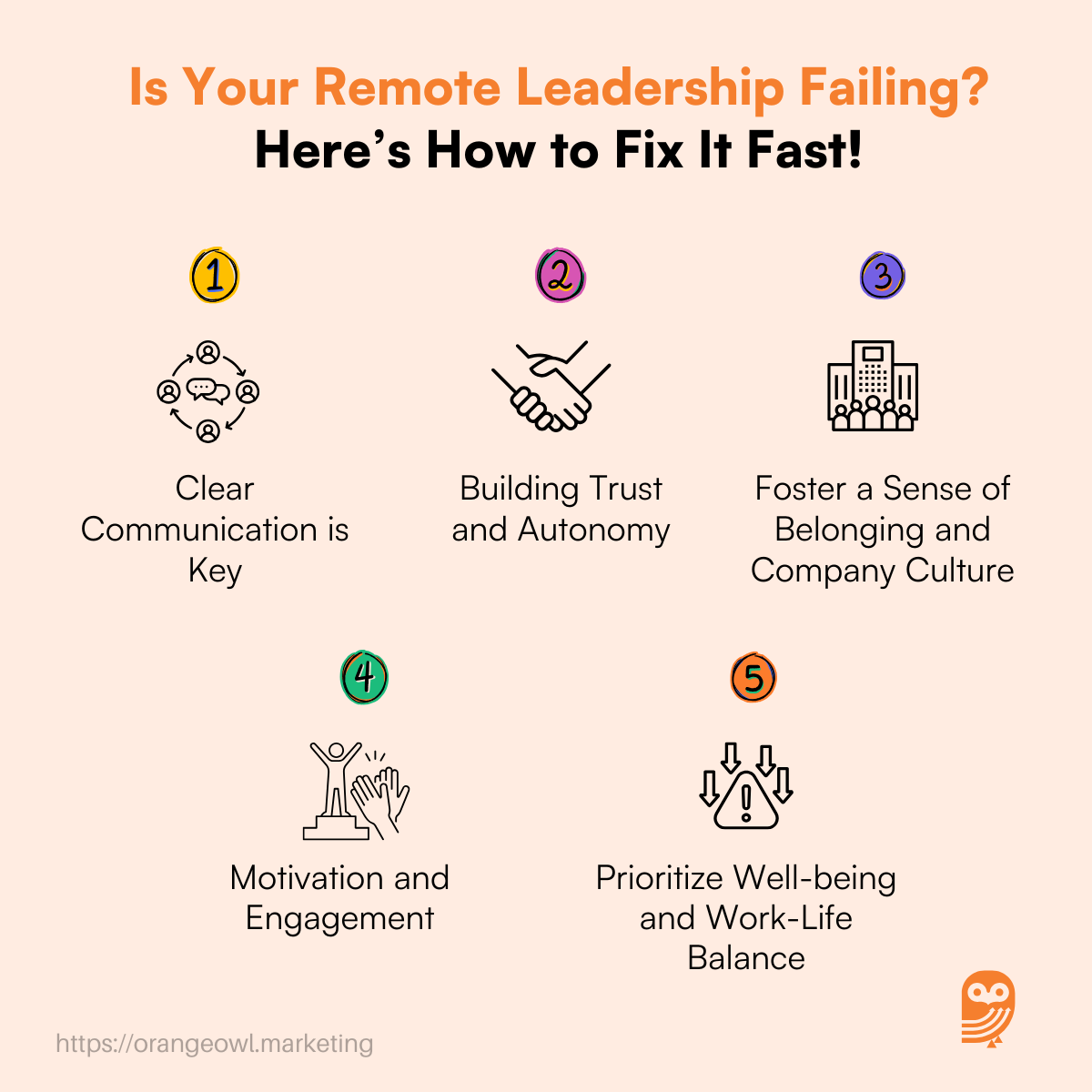1. Clear Communication is Key
Effective communication is at the heart of remote leadership. Unlike in-office environments where spontaneous chats and face-to-face meetings are easy, remote work demands deliberate and clear communication strategies.
Best Practice:
Set up regular check-ins: Daily or weekly meetings via video conferencing (e.g., Zoom, Microsoft Teams) help maintain team alignment. At Orange Owl, we hold weekly team huddles to discuss goals, progress, and challenges.
Use collaborative tools: Tools like Slack, Trello, and Asana are vital for keeping everyone on the same page. At Orange Owl, we use Slack channels for specific teams and projects to ensure transparency and ease of access.
Clarify expectations: Clear communication of goals, deadlines, and responsibilities is essential. Use detailed project outlines and checklists to avoid ambiguity.
Practical Example:
A remote team working on a large product launch uses Trello to manage tasks and keeps in constant communication via Slack. Daily check-ins help keep everyone on the same page, allowing for real-time updates and adjustments to the plan, even when the team is spread across multiple time zones.
2. Building Trust and Autonomy
Remote leadership requires leaders to trust their team members to work independently. Micromanaging doesn’t work when teams are distributed; instead, fostering trust is essential.
Best Practice:
Empower decision-making: Encourage team members to take ownership of their work. This boosts their confidence and enables them to be more productive.
Avoid micromanagement: Instead of checking in on every task, focus on the overall results. At Orange Owl, we give team members the freedom to choose how they complete their tasks as long as the outcomes align with business goals.
Provide resources for success: Make sure your team has the necessary tools and training to succeed on their own.
Practical Example:
A remote marketing team is given full control over the execution of a major ad campaign. The team is responsible for strategizing, executing, and tracking the campaign’s performance. By empowering the team, they deliver a successful campaign that exceeds the set performance metrics, demonstrating the power of autonomy.

3. Foster a Sense of Belonging and Company Culture
One of the biggest challenges of remote work is maintaining a strong sense of company culture. It’s easy for team members to feel isolated when working from different locations.
Best Practice:
Create virtual social spaces: Encourage informal interactions. For example, we have a virtual coffee chat channel in Slack where team members can discuss non-work topics.
Celebrate wins together: Acknowledge both big and small accomplishments publicly. This fosters a sense of community and pride in the work.
Onboard new employees remotely: When you hire new team members, make sure the onboarding process is thorough and interactive, involving them in team-meetings and introducing them to key people.
Practical Example:
A company sets up a virtual happy hour once a month, where employees can join for casual chats and games. This initiative helps new team members feel welcomed and helps the existing team bond, despite working remotely. Additionally, new employees are paired with mentors who help them navigate their first few weeks with the company.
4. Motivation and Engagement
Keeping remote employees motivated and engaged requires continuous effort. Without in-person interactions, it’s easy for motivation to wane.
Best Practice:
Offer flexible work hours: Many remote workers value flexibility. Let them create a schedule that works best for their productivity while aligning with team goals.
Recognize individual contributions: Publicly appreciate team members for their hard work and unique strengths. Personalized recognition goes a long way in boosting morale.
Provide growth opportunities: Even remotely, it’s essential to provide team members with chances for career advancement. This could include online courses, mentorship, or challenging new projects.
Practical Example:
A remote team leader allows employees to set their own work hours, which leads to increased job satisfaction and productivity. Employees are encouraged to pursue professional development opportunities, such as online courses, which also helps them stay engaged and motivated in their roles.
5. Prioritize Well-being and Work-Life Balance
Remote leadership goes beyond work tasks – it includes ensuring your team’s well-being.
Best Practice:
Encourage breaks: Remind employees to take breaks and avoid burnout, especially when working from home.
Promote mental health awareness: Make mental health resources available and be open about the importance of mental well-being in the workplace.
Support work-life balance: Make it clear that it’s okay to disconnect after working hours and to use vacation time to recharge.
Practical Example:
A remote team adopts a “No Work on Weekends” policy, encouraging employees to completely disconnect after work hours. Additionally, they offer a wellness stipend that employees can use for activities such as fitness classes or meditation sessions. This approach helps employees avoid burnout and boosts overall productivity.
Conclusion: The Future of Remote Leadership
As remote and hybrid work continue to thrive, remote leadership will only become more integral to a company’s success. By embracing clear communication, building trust, fostering a strong sense of culture, keeping employees motivated, and prioritizing well-being, remote leaders can create thriving, efficient teams that deliver results.



